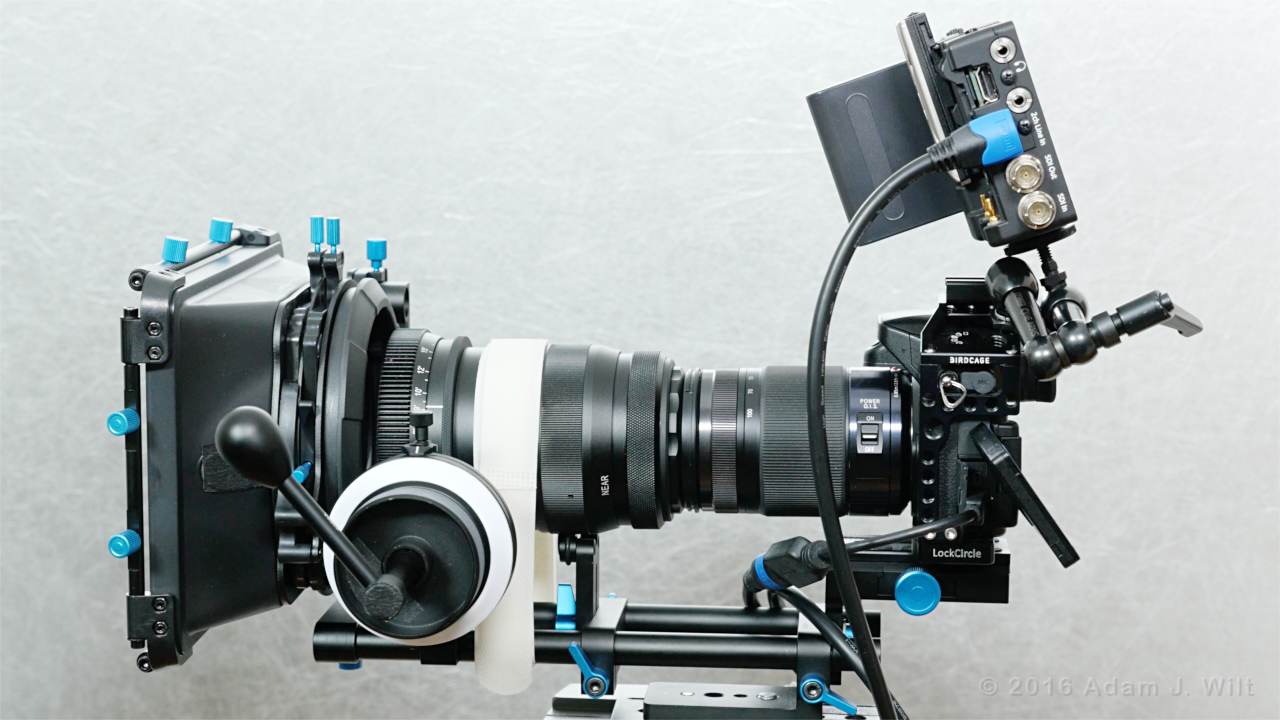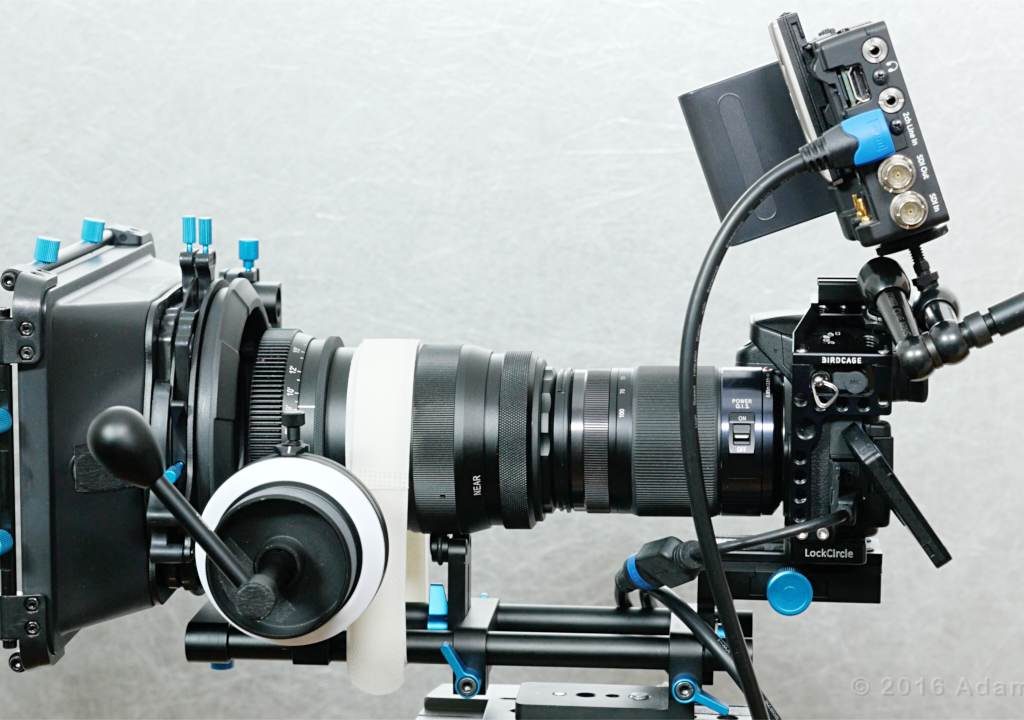I did a webinar for Moviola on Affordable Anamorphic Adapters today; it’s available for replay at Moviola. Here are the intro notes, plus references and links for topics I discussed.
Introduction
Low-cost anamorphic adapters are a great way to dabble with shooting sideways-squashed images and reaping the benefits thereof, like horizontal flare, oval bokeh, and disproportionate breathing. However, these adapters have their own idosyncracies: alignment sensitivity, focusing peculiarities, and a tendency to turn small cameras into Frankenstein rigs.

Tune in for a brief introduction to the topic. I cover both theory and practice, and reveal where the magic number 2.38694638694639 comes from. If I did my job right, you’ll either be entranced and enthused, or shocked and appalled—and either reaction will be equally valid!
But there’s a lot I wasn’t able to cover, and lots of info you may want links for, so here it all is. All links are current as of late September 2016… but links rot. Apologies in advance!
What didn’t you cover in the video?
Diopters: these add-on close-up lenses were the only way to get good close-focusing performance with many adapters prior to the created from single-focus attachments, which are themselves variable diopters.
Prices: generally speaking, vintage adapters run from $200–$1000, though classic, single-focus Iscoramas can run upwards of $2000. New SLR Magics are $850—$1200 while the clamp-on Letus35 AnamorphX adapters are around $1700-$2700. The Letus35 GoPro lens is $234 while the Moondog Labs iPhone lenses are $175. Single-focus attachments run $600–$1000 (SLR Magic offers bundles combining anamorphic adapters and focus attachments for additional savings). All told, you should be able to put together a very workable system for under $1500 to $2000.
Sources for vintage glass: eBay. I found two vendors that have good selections of glass and tell you exactly what you’re getting, which is crucial. Both of them are very responsive, too. anamorphiclenses focuses entirely on anamorphics; jmvanauto has a large selection of (mostly) projection anamorphics. I used their listings and graphics in the webinar, with their permission. Also, check the forums at EOSHD and personal-view, listed below.
Where do I get the new stuff?
SLR Magic: They have a UK Website (despite being a Hong Kong company), but in North America your best bets are probably B&H and Adorama.
Letus AnamorphX adapters, including 1.33x adapters for GoPros and a somewhat odd 1.8x adapter. More options at B&H and Adorama. Interestingly, the AnamorphX adapters are available in three different flare levels!
Moondog Labs 1.33x adapters for iPhones.
Rectilux: There’s a website, but most of the current action is on facebook. Also, PDFs for the 3FF and the CoreDNA.
Focus Module: out of production? But keep an eye on Anamorphic Shop for news of the upcoming Focus Module 2.
Richard Gale Optics Olivia Scope 1.5x: Coming soon… but there are prototype videos already.
Clamps and mounts: Check out Redstan, Rapido, and Vid-Atlantic.
References?
Panavision’s 5 Pillars of Anamorphic – a series of videos that illustrate key elements of “the anamorphic look”.
Tito Ferradans’s Anamorphics on a Budget – Tito studied budget anamorphics—ancient Lomo lenses, vintage adapters, modern adapters, and associated accessories—as the core of his university work. There’s no better place I know of to get up to speed on the world of affordable anamorphics: his articles and videos are clear, comprehensive, and thoughtfully put together… and current; at this time his most recent post (on the FM Lens) is less than a month old.
Online forums: the EOSHD Anamorphic Forum is self-described as “[t]he largest online community devoted to anamorphic filmmaking.” Anamorphic topics at personal-view: most of the affordable-anamorphics discussions in the world that aren’t on EOSHD are here instead.
Andrew Reid at EOSHD has posted plenty of anamorphic tests, reviews, and demo clips.
The $20 EOSHD Anamorphic Shooter’s Guide, 2nd edition, is Andrew Reid’s 41-page eBook. Published in 2012, it lacks coverage of the more recent SLR Magic adapters and the single-focus attachments, and as a result gives short shrift to the Schneider projection lenses which need those focus attachments to be useful. Discussion of the GH2 hack and FCP 7 workflows may be dated, but Andrew’s practical reviews of vintage glass, taking lenses, diopters, usable viewing angles, etc. are as valuable as ever. Andrew says that the 3rd edition, with all the recent developments, will come out later this year. My guess is it’ll cost more than $20.
The American Widescreen Museum covers the history and development of widescreen cinema, including both anamorphic and non-anamorphic processes. The webinar pix of the CinemaScope poster and the Hypergonar lens are pages from this site, used with permission. If you’re interested in the wide world of widescreen, this is the place to start.
What did you use, and why?
I bought a second-hand Panasonic AG-LA7200 1.33x adapter in 2004 to use on a DVX100, and I’ve had it ever since. Andrew Chan at SLR Magic sent me early versions of the 1.33x ANAMORPHOT and 2.0x ANAMORPHOT adapters for review. When I asked about shipping ‘em back, I was told to keep ‘em (there was no quid pro quo offer of lenses for favorable reviews, at least none I was aware of). Since those were the lenses I already had access to, those are what I used.
I bought a used SLR Magic Rangefinder single-focus adapter a few months ago out of curiosity. I haven’t written a review of it yet, but I will. (Both Adorama and B&H have used ones for sale fairly frequently; I got mine from Adorama.)
The Odyssey is on loan from Convergent Design for beta-testing and review purposes. The PIX-E is a development unit left over from my work on its UI and ‘scopes (and anamorphic menus, grin). The Zacuto EVF I bought used a few years ago. The GH4, its lenses, and the support kit were all bought at market prices over the past few years.
Nobody offered me any deals to use any of this stuff for the webinar.
Does that mean I should buy the same kit?
Not necessarily!
The SLR Magic stuff has the advantages of being currently manufactured and widely available; if you drop your adapter and break it, you can get a replacement overnight, which is a great comfort if you use the gear professionally.
However, the ANAMORPHOTS generally need to have the taking lens stopped down for adequate performance; SLR Magic’s instructions for the 1.33x say…
f/2.8 should be used for 20-50mm focal length.
f/4.0 should be used for 55-85mm focal length.
f/5.6 should be used for 90-135mm (Trial and error) focal length.
… while the 2.0x is even fussier.
The Rangefinder single-focus adapter adds a layer of softness and flare all its own; figure on closing down at least another stop for acceptable sharpness, and just give up on the corners of the image: they’ll be soft and smeary no matter what.
Now, there’s nothing wrong with a little stopping down—some professional anamorphic lenses are notoriously soft wide open—and the softness and aberrations definitely impart “an organic look”. But if you’re a sharpness fiend, or you need to work at wide apertures, you may want to look elsewhere.
I have no personal experience with other anamorphic setups, but by most reports, a good vintage anamorphic adapter combined with a Rectilux single-focus attachment will yield crisp images corner-to-corner even with the taking lens wide open (look at the moon in this video for an example). The Kowa 16 gets multiple votes for sharpness, as do the Schneider Cinelux projection lenses.
The drawbacks? Rectilux adapters are small-volume batch-production items and so they often aren’t available at a moment’s notice. The lenses they mate with are typically years old and vary considerably in mechanical and optical condition. If you drop a vintage/Rectilux combo and damage it, you may not be able to have it repaired or replaced on a moment’s notice. If you’re shooting for a living this can put a real crimp in your style.
Doesn’t SLR Magic make standalone anamorphics, too?
Yup, 2.0x for MFT mount and 1.33x for PL mount. $2600 to $6500 each. (Affordable compared to Cookes and Master Primes perhaps, but even so, that ain’t chump change!)
How ‘bout those Veydra anamorphics?
Sadly, Veydra decided not to make them.
What the heck does that last question have to do with adapters, fercryinoutloud???
Not a darned thing, sorry. I just figured the question might come up since I mentioned those lenses in my ANAMORPHOT 2.0x review and I know at least three people in the audience have been waiting for them.
I saw some color shifts when you changed adapters…
Yup, I shot with fixed white balance and didn’t correct in post. The adapters have their own particular color renderings and the Rangefinder definitely warms the picture considerably. Something to consider if you mix footage with/without the various adapters.
What’s the deal with the rabbit?
Barney is the only assistant I can get to sit still for me.
What webpages did you show in the webinar?
A whole bunch!
http://www.widescreenmuseum.com/widescreen/wingcs3.htm
http://www.fdtimes.com/2016/08/22/scorpio-138-405-t4-3-anamorphic-zoom/
http://www.fdtimes.com/2016/04/19/hawk-v-lite-1-3x-vintage-74-anamorphics/
http://www.fdtimes.com/2016/04/14/cooke-45-405-t4-5-anamorphici-zoom/
https://www.provideocoalition.com/70to200anamorphiczoom
https://www.provideocoalition.com/P%2BSTechnik_Zoom
http://panalab.panavision.com/panalab-seminars
https://www.vantagefilm.com/en/products/hawk-anamorphic/hawk-2x
https://www.zgc.com/s/p/cooke-zgc-cookeana.html
https://www.abelcine.com/store/Arri-Zeiss-Master-Anamorphic-Primes/
http://www.tferradans.com/blog/?page_id=5268
https://www.provideocoalition.com/entering-production-slr-magic-anamorphot-133-x50/
https://www.provideocoalition.com/preview-slr-magic-anamorphot-133×50-anamorphic-adapter/
https://www.provideocoalition.com/review-slr-magic-anamorphot-133x-50-anamorphic-adapter/
https://www.provideocoalition.com/preview-slr-magic-anamorphot-2-0x-50-anamorphic-adapter/
http://www.ebay.com/sch/anamorphiclenses/m.html?_nkw=&_armrs=1&_ipg=&_from=
https://www.bhphotovideo.com/c/search?Ntt=anamorphic+adapter+1.33
http://www.tferradans.com/blog/?p=7204
http://www.widescreenmuseum.com/widescreen/wingcs1.htm
http://www.tferradans.com/blog/?p=7225
http://www.richardgaleoptics.uk/olivia-scope-15x/olivia-scope-15x-pre-order
http://www.tferradans.com/blog/?p=8183
http://www.tferradans.com/blog/?page_id=5268
http://www.transferconvert.co.uk/cinemania/rectilux-3ff.html
http://www.transferconvert.co.uk/cinemania/Rectilux3FFBrochureAug2015.pdf
http://www.transferconvert.co.uk/cinemania/PressReleaseRectiluxCoreDNA.pdf
http://anamorphicshop.com/product/fm-lens/
http://www.redstan.com/index.php?route=product/category&path=33&page=1
http://www.rapidotechnology.com
http://www.vid-atlantic.com/products/anamorphic-lens-clamp
https://www.bhphotovideo.com/c/product/1195990-REG/slr_magic_slra50_2x_anamorphot_50_2x.html
https://www.bhphotovideo.com/c/product/1016542-REG/letus35_lt_anx_m_anamorphx_adapter_medium.html
So, there you have it.
[vc_column][vc_row]
[vc_cta_button call_text=”Watch On-Demand on moviola.com” title=”View Now!” target=”_blank” color=”btn-success” icon=”none” size=”btn-large” position=”cta_align_right” href=”http://moviola.com/webinars/affordable-anamorphic-adapters/”]
[/vc_column]

Filmtools
Filmmakers go-to destination for pre-production, production & post production equipment!
Shop Now














